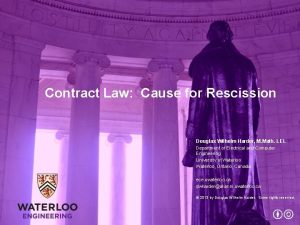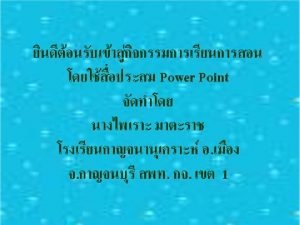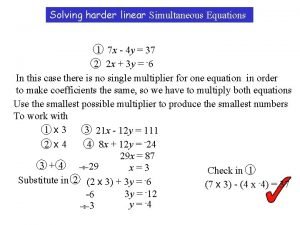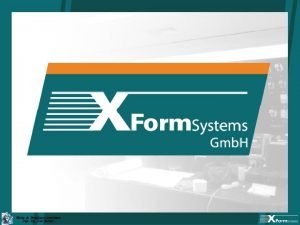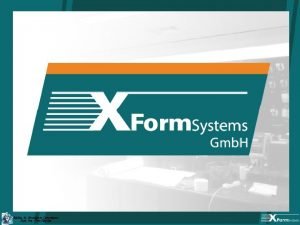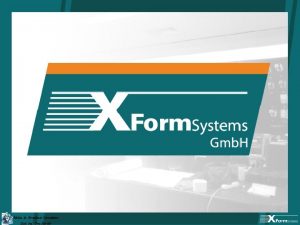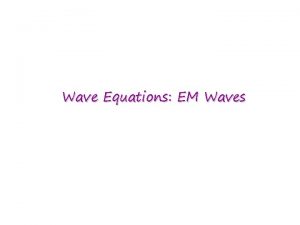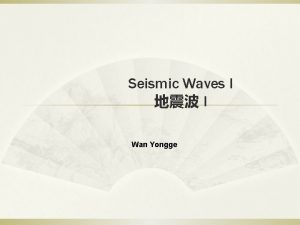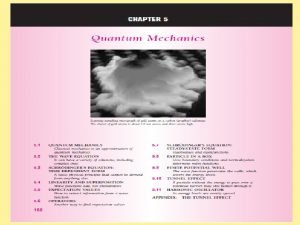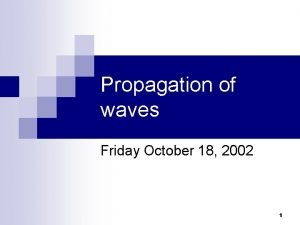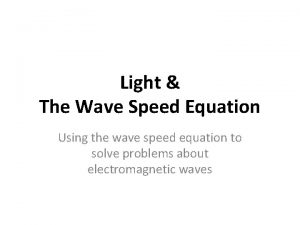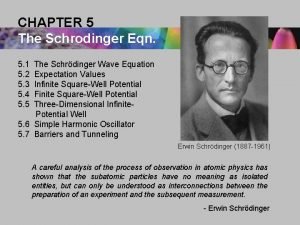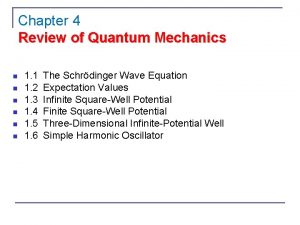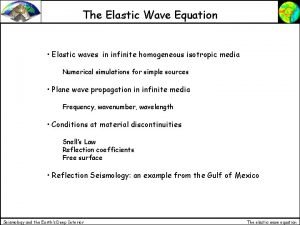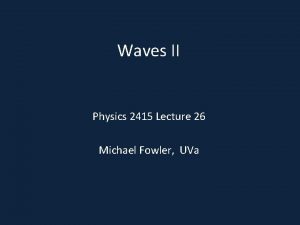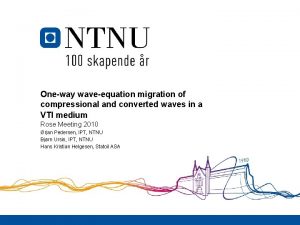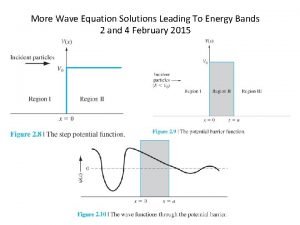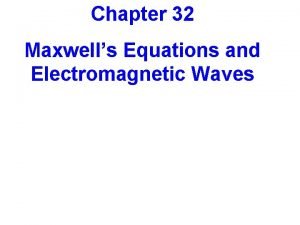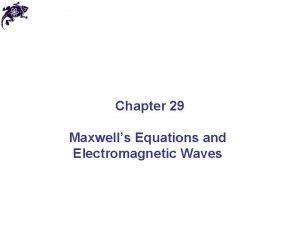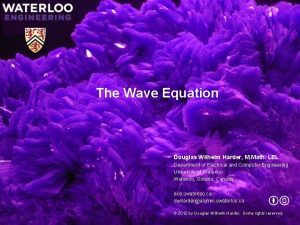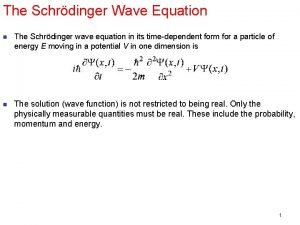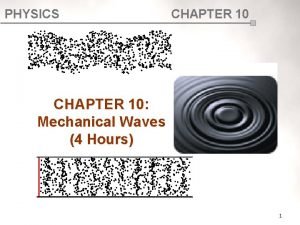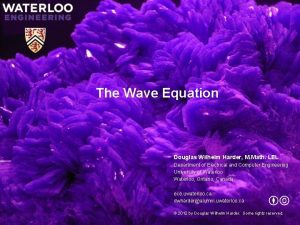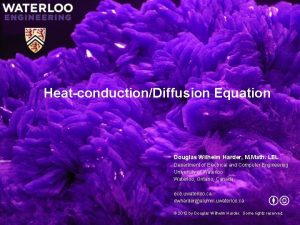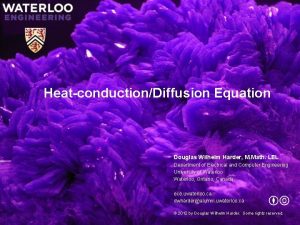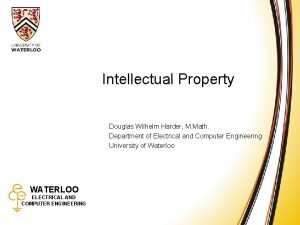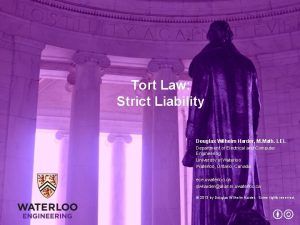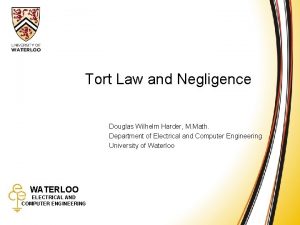The Wave Equation Douglas Wilhelm Harder M Math



















































![Wave Equation References [1] Glyn James, Modern Engineering Mathematics, 4 th Ed. , Prentice Wave Equation References [1] Glyn James, Modern Engineering Mathematics, 4 th Ed. , Prentice](https://slidetodoc.com/presentation_image/965855cfcfed16d611e9bc8d705090f6/image-52.jpg)
- Slides: 52

The Wave Equation Douglas Wilhelm Harder, M. Math. LEL Department of Electrical and Computer Engineering University of Waterloo, Ontario, Canada ece. uwaterloo. ca dwharder@alumni. uwaterloo. ca © 2012 by Douglas Wilhelm Harder. Some rights reserved.

Wave Equation Outline This topic discusses numerical solutions to the wave equation: – Discuss the physical problem and properties – Examine the equation – Approximate solutions using a finite-difference equation • Consider numerical stability • Examples – What about Crank-Nicolson? 2

Wave Equation Outcomes Based Learning Objectives By the end of this laboratory, you will: – Understand the wave equation – Understand how to approximate partial differential equations using finite-difference equations – Set up solutions in one spatial dimension – Deal with insulated boundary conditions 3

Wave Equation Motivating Example Suppose we start with a string at rest 4

Wave Equation Motivating Example Someone comes along and plucks the string 5

Wave Equation Motivating Example After letting go, the string begins to vibrate – Energy is transferred to the air producing sound 6

Wave Equation Motivating Example Some things to note: The string – Is at rest when it is a solution to Laplace’s equation – Acceleration is towards the solution of Laplace’s equation 7

Wave Equation Motivating Example In addition, if we reduce the length of a string, the vibrations increase: – Halve the length of a string, double the frequency – If a string of a certain length is middle C, a string of half the length is one octave higher 8

Wave Equation Motivating Example Waves are not restricted to strings: – The vibrations on the face of a drum – The ripples on the surface of a pond – The movement of light (microwaves, radio waves, etc. ) 9

Wave Equation The equation that describes the propagation of waves under somewhat ideal circumstances is given by the partial differential equation where u(x, t) is a real-valued function of space and time and c is the propagation speed of the wave Sound in air at 20 o. C Light c ≈ 343 m/s = 1234. 8 km/h ≈ 1 km/3 s c = 299 792 458 m/s 10

Wave Equation The Wave Equation For water in a deep ocean, the speed is proportional to the square root of the wave length: Wavelength (m) 1 Speed (m/s) 2. 5 10 4 100 12. 5 1000 39 140 km/h 11

Wave Equation The Laplacian Operator Notice if that u(x, t) already satisfies Laplace’s equation, then or That is, if a solution already satisfies Laplace’s equation, it will not be accelerating – In one dimension, if the string is already tight (a straight line), it will not begin vibrating – If it’s not moving, either, it will remain fixed 12

Wave Equation Acceleration Proportional to Concavity In one dimension, what does this equation mean? 13

Wave Equation Acceleration Proportional to Concavity We can see this visually: – If the function u is concave up at (x, t), the acceleration of u over time will be positive 14

Wave Equation Acceleration Proportional to Concavity We can see this visually: – If the function u is concave down at (x, t), the acceleration of u over time will be negative 15

Wave Equation Initial and Boundary Conditions For a 2 nd-order ODE, we require either two initial conditions Time variables are usually associated with initial conditions or a boundary condition: Space variables are usually associated with boundary conditions 16

Wave Equation Initial and Boundary Conditions For the wave equation, we have two second partial derivatives: – One in time – One in space 17

Wave Equation Initial and Boundary Conditions For the wave equation, we require – For each space coordinate: • An initial value at each point, and • An initial velocity at each point – For each time coordinate • Boundary conditions at the end points in space 18

Wave Equation The Wave Equation Given the wave equation and the two approximations of the second partial derivatives we will substitute the approximations into the equation 19

Wave Equation The Wave Equation This gives us our finite-difference equation 20

Wave Equation The Wave Equation This gives us our finite-difference equation Note that there is only one term in the future: u(x, t + Dt) – We assume we have approximations for t and t – Dt – Solve for u(x, t + Dt) 21

Wave Equation The Wave Equation This gives us our finite-difference equation Substituting we get 22

Wave Equation The Wave Equation As before, we will substitute and recognize that to get 23

Wave Equation Initial and Boundary Conditions The boundary conditions will be given by the functions – uinit(x) – Duinit(x) The initial value of the function u(x, t 0) The initial rate of change u(x, t 0) – abndry(t) – bbndry(t) The boundary value of the function u(a, t) The boundary value of the function u(b, t) As with the previous cases, we will define the latter two as a single vector-valued function 24

Wave Equation Initial and Boundary Conditions We will define two functions u_init( x ) du_init( x ) u_bndry( t ) where – u_init and u_bndry are the same as before – du_init takes an n-dimensional column vector x as an argument and returns an n-dimensional vector of the initial speeds 25

Wave Equation Approximating the Solution Just as we did with BVPs and the heatconduction/diffusion equation, we will divide the spacial interval [a, b] into nx points or nx – 1 sub-intervals 26

Wave Equation Approximating the Solution We want to approximate the state at time t = t 2 but consider the formula with k = 1: We don’t have access to ui, 0 27

Wave Equation Approximating the Solution To solve this, we will use the initial conditions: ui, 2 = ui, 1 + Dt Dui, 1 – This is simply an application of Euler’s method 28

Wave Equation Approximating the Solution For the next point, t = t 3 , however, we can go back to using the finite-difference formula: 29

Wave Equation Approximating the Solution And from here on, we can continue using the formula 30

Wave Equation Insulated Boundaries As this is a forward solving algorithm, if we have insulated boundaries, it is straight forward – Insulated boundaries reflect waves We will solve for the values at times k = 1, …, nt – 1 – We will first solve for the values u 2, k through unx – 1, k , – If u 1, k is marked as insulated (Na. N), we will replace it with u 2, k – If un x , k is marked as insulated (Na. N), we will replace it with un x – 1, k 31

Wave Equation Steps to the Problem Previously, the steps were: 1. Error checking (if necessary) 2. Initialization 3. Solving the problem When we solve BVPs, Step 3. was broken into: a. b. c. d. Generate the matrix and vector for solving Muintr = b Modify the first and last entries of b Solve the system of linear equations Add ua and ub back to the result 32

Wave Equation Steps to the Problem Previously, the steps were: 1. Error checking (if necessary) 2. Initialization 3. Solving the problem When we solve the heat-conduction/diffusion equation, Step 3. was broken into: For each time step k = 1, 2, …, nt – 1 a. Apply the formula to approximate ui, k + 1 33

Wave Equation Steps to the Problem Previously, the steps were: 1. Error checking (if necessary) 2. Initialization 3. Solving the problem When we applied the Crank-Nicolson method, Step 3. was broken into: For each time step k = 1, 2, …, nt – 1 a. Generate the matrix and vector for solving Muintr = b b. Modify the first and last entries of b c. Solve the system of linear equations to approximate ui, k + 1 34

Wave Equation Steps to the Problem Previously, the steps were: 1. Error checking (if necessary) 2. Initialization 3. Solving the problem When we applied the Crank-Nicolson method adding insulated boundary conditions, Step 3. was broken into: For each time step k = 1, 2, …, nt – 1 a. b. c. d. Generate the matrix and vector for solving Muintr = b Modify, as appropriate, the vector b or the matrix M Solve the system of linear equations to approximate ui, k + 1 As appropriate, update any insulated boundary conditions 35

Wave Equation Steps to the Problem Now we are solving the wave equation: 1. 2. 3. 4. Error checking: Initialization Solve for the special case at time t 2 Solving the problem for the general case When we solved the adding insulated boundary conditions, Step 4 was broken into: For each time step k = 2, 3, …, nt – 1 a. Apply the formula to approximate ui, k + 1 b. As appropriate, update any insulated boundary conditions 36

Wave Equation Step 1: Error Checking Once the parameters are validated, the next step is to ensure If this condition is not met, we should exit and provide a useful error message to the user: – For example, The ratio (c*dt/h)^2 = ? ? ? >= 1, consider using nt = ? ? ? where • The first ? ? ? is replaced by the calculated ratio, and • The second ? ? ? is found by calculating the smallest integer for nt that would be acceptable to bring this ratio under 1 – You may wish to read up on the floor and ceil commands 37

Wave Equation Step 1: Error Checking Essentially, given c, t 0, tfinal and h, find an appropriate value (that is, the smallest integer value) of nt* to ensure that Very similar to constraints on for the heat- conduction/diffusion equation 38

Wave Equation Step 2: Initialization It would still be useful to initialize the matrix U and then use the values as appropriate nt nx 39

Wave Equation Step 3: Solving at time t 2 We then proceed to evaluate the next column using the straight-forward application of Euler’s method nt nx 40

Wave Equation Step 4: Solving Thus, we have approximations for the values u 2, 2 through un – 1, 2 x – We may have to adjust these if we have insulated boundary conditions nt nx 41

Wave Equation Step 4: Solving As with the previous case, we will find solutions for the t for t through t interior points 2 n nt nx 42

Wave Equation Step 4: Solving As with the previous case, we will find solutions for the t for t through t interior points 2 n – Again, at each step, we may have to adjust any boundary values indicating insulated boundary conditions nt nx 43

Wave Equation Example 1 As a first example: [x 4 a, t 4 a, U 4 a] = wave 1 d( 1, [0, pi], size(x 4 a) ans = 10 1 10, [0, 10], 42, @u 4 a_init, @du 4 a_init, @u 4 a_bndry ); c = 1. 0 >> size(t 4 a) ans = 1 30 >> size(U 4 a) ans = 10 30 b 4 a, bndry (t) = 0. 0 u 4 a, init(x) = sin(x) Du 4 a, init(x) = 0 >> mesh( t 4 a, x 4 a, U 4 a ) a 4 a, bndry (t) = 0. 0 b=p nx = 10 x a=0 t t 0 = 0 tfinal = 10 nt = 42 44

Wave Equation Example 1 As a first example: [x 4 a, t 4 a, U 4 a] = wave 1 d( 1, [0, pi], mesh( t 4 a, x 4 a, U 4 a ) 10, [0, 10], 42, @u 4 a_init, @du 4 a_init, @u 4 a_bndry ); c = 1. 0 b 4 a, bndry (t) = 0. 0 u 4 a, init(x) = sin(x) Du 4 a, init(x) = 0 function [u] = u 4 a_init(x) u = sin(x); end function [u] = du 4 a_init(x) u = 0*x; end function [u] = u 4 a_bndry(t) u = [0*t; 0*t]; end a 4 a, bndry (t) = 0. 0 b=p nx = 10 x a=0 t t 0 = 0 tfinal = 10 nt = 42 45

Wave Equation Example 1 Selecting the Rotate 3 D icon allows you to rotate the image 46

Wave Equation Example 2 If we start with a straight line and create a pulse (like with slinkies), we get the following wave [x 4 b, t 4 b, U 4 b] = wave 1 d( 1, [0, 10], 50, [0, 45], 350, @u 4 b_init, @du 4 b_init, @u 4 b_bndry ); mesh( t 4 b, x 4 b, U 4 b ); frames 4 b = animate( U 4 b ); frames 2 gif( frames 4 b, 'plot 4 b. i. gif' ); 1 0 t x function [u] = u 4 c_bndry(t) u = [(1 - cos(t)). *(t <= 2*pi); 0*t]; end – 1 47

Wave Equation Example 2 Suppose we allow the one end to move freely: – This would represent an insulated boundary [x 4 b, t 4 b, U 4 b] = wave 1 d( 1, [0, 10], 50, [0, 45], 350, @u 4 b_init, @du 4 b_init, @u 4 b_bndry ); mesh( t 4 b, x 4 b, U 4 b ); frames 4 b = animate( U 4 b ); frames 2 gif( frames 4 b, 'plot 4 b. ii. gif' ); 2 1 0 – 1 t x function [u] = u 4 c_bndry(t) u = [(1 - cos(t)). *(t <= 2*pi); Na. N*t]; end – 2 48

Wave Equation Example 3 If we exceed 1, the approximation diverges: [x 4 b, t 4 b, U 4 b] = wave 1 d( 1, [0, 10], 50, [0, 45], 221, @u 4 b_init, @du 4 b_init, @u 4 b_bndry ); mesh( t 4 b, x 4 b, U 4 b ); frames 4 b = animate( U 4 b, [-3, 3] ); frames 2 gif( frames 4 c, 'plot 4 b. iii. gif' ); 3 0 x – 3 t 49

Wave Equation Crank-Nicolson and Implicit Methods? What about using the ideas from the Crank-Nicolson approach – Without justification, I tried to incorporate the method – The method, however, did not decrease the error—it significantly increased it 50

Wave Equation Summary We have looked at the wave equation – Considered the physical problem – Considered the effects in one dimension – Found a finite-difference equation approximating the wave equation • Saw that • Examples – We considered insulated boundaries 51
![Wave Equation References 1 Glyn James Modern Engineering Mathematics 4 th Ed Prentice Wave Equation References [1] Glyn James, Modern Engineering Mathematics, 4 th Ed. , Prentice](https://slidetodoc.com/presentation_image/965855cfcfed16d611e9bc8d705090f6/image-52.jpg)
Wave Equation References [1] Glyn James, Modern Engineering Mathematics, 4 th Ed. , Prentice Hall, 2007, p. 778. [2] Glyn James, Advanced Modern Engineering Mathematics, 4 th Ed. , Prentice Hall, 2011, p. 164. 52
 Douglas wilhelm harder
Douglas wilhelm harder Douglas wilhelm harder
Douglas wilhelm harder Douglas harder
Douglas harder Sigit
Sigit Peo negligent misrepresentation
Peo negligent misrepresentation Senge fifth discipline summary
Senge fifth discipline summary Sound waves are electromagnetic waves true or false
Sound waves are electromagnetic waves true or false Long waves and short waves
Long waves and short waves Difference between full wave and half wave rectifier
Difference between full wave and half wave rectifier Transverse and longitudnal waves
Transverse and longitudnal waves Half wave rectifier definition
Half wave rectifier definition Half wave rectifier mathematical analysis
Half wave rectifier mathematical analysis P and s wave arrival time chart
P and s wave arrival time chart Full wave rectified sine wave fourier series
Full wave rectified sine wave fourier series What is a repeating disturbance
What is a repeating disturbance Wave wave repeating
Wave wave repeating What is quarter wave symmetry
What is quarter wave symmetry Mechanical and electromagnetic waves
Mechanical and electromagnetic waves Example of mechanical waves
Example of mechanical waves Wavelength formula triangle
Wavelength formula triangle Work smarter, not harder essay
Work smarter, not harder essay If you studied hard you would have passed the exam
If you studied hard you would have passed the exam My father said to me, you must work hard
My father said to me, you must work hard Descriptive vs evaluative feedback
Descriptive vs evaluative feedback Simultaneous equations non linear
Simultaneous equations non linear Pray for those who are hungry, pray harder
Pray for those who are hungry, pray harder Uwe harder
Uwe harder Uwe harder
Uwe harder Uwe harder
Uwe harder Try harder
Try harder Try harder
Try harder Never work harder than your students
Never work harder than your students Type 3 conditional examples
Type 3 conditional examples Is copper harder than steel
Is copper harder than steel Work smarter not harder passage
Work smarter not harder passage How did the plague make life harder for jews in europe?
How did the plague make life harder for jews in europe? Topmarks
Topmarks Spherical wave equation
Spherical wave equation 4 characteristics of seismic waves
4 characteristics of seismic waves General solution of wave equation
General solution of wave equation Line source
Line source Wave speed equation practice problems
Wave speed equation practice problems Derivation of time independent schrodinger equation
Derivation of time independent schrodinger equation Review of quantum mechanics
Review of quantum mechanics Wave velocity formula
Wave velocity formula What is a harmonic wave in physics
What is a harmonic wave in physics One way wave equation
One way wave equation Electron mass
Electron mass Energy of em wave
Energy of em wave Theory of james clerk maxwell
Theory of james clerk maxwell Wave equation formula
Wave equation formula Expectation value in quantum mechanics
Expectation value in quantum mechanics Mechanical wave formula
Mechanical wave formula

